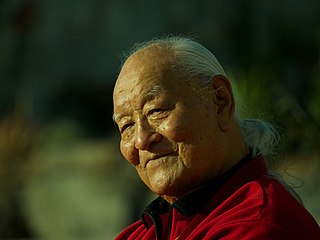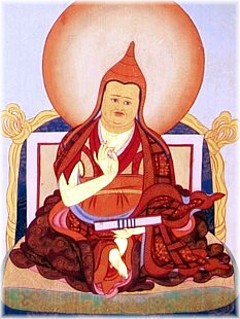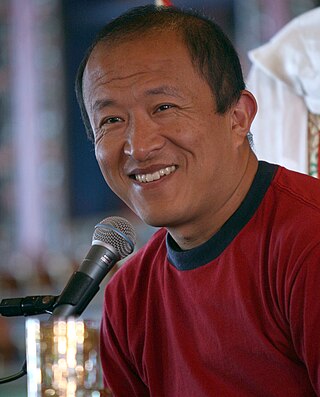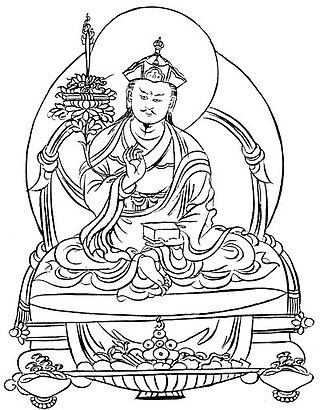A tulku is a distinctive and significant aspect of Tibetan Buddhism, embodying the concept of enlightened beings taking corporeal forms to continue the lineage of specific teachings. The term "tulku" has its origins in the Tibetan word "sprul sku", which originally referred to an emperor or ruler taking human form on Earth, signifying a divine incarnation. Over time, this term evolved within Tibetan Buddhism to denote the corporeal existence of highly accomplished Buddhist masters whose purpose is to ensure the preservation and transmission of a particular lineage.

Dilgo Khyentse Rinpoche, Tashi Paljor was a Vajrayana master, Terton, scholar, poet, teacher, and recognized by Buddhists as one of the greatest realized masters. Head of the Nyingma school of Tibetan Buddhism from 1988 to 1991, he is also considered an eminent proponent of the Rime tradition.

The Chogyal were the monarchs of the former Kingdom of Sikkim, which belonged to the Namgyal dynasty. The Chogyal was the absolute monarch of Sikkim from 1642 to 1973, and the constitutional monarch from 1973 to 1975, when the monarchy was abolished and the Sikkimese people voted in a referendum to make Sikkim the 22nd state of India.

The 7th Dalai Lama, Kelzang Gyatso, was recognized as the authentic 7th Dalai Lama of Tibet. He was seen as the true incarnation of the 6th Dalai Lama, and was enthroned after a pretender supported by the Koshut Khan was deposed.

Namkhai Norbu was a Tibetan Buddhist master of Dzogchen and a professor of Tibetan and Mongolian language and literature at Naples Eastern University. He was a leading authority on Tibetan culture, particularly in the fields of history, literature, traditional religions, and Traditional Tibetan medicine, having written numerous books and scholarly articles on these subjects.

Jamgön Ju Mipham Gyatso, or Mipham Jamyang Namgyal Gyamtso (1846–1912) was a very influential philosopher and polymath of the Nyingma school of Tibetan Buddhism. He wrote over 32 volumes on topics such as painting, poetics, sculpture, alchemy, medicine, logic, philosophy and tantra. Mipham's works are still central to the scholastic curriculum in Nyingma monasteries today. Mipham is also considered to be one of the leading figures in the Rimé (non-sectarian) movement in Tibet.

Dzongsar Jamyang Khyentse Rinpoche, also known as Khyentse Norbu, is a Bhutanese lama, filmmaker, and writer. His five major films are The Cup (1999), Travellers and Magicians (2003), Vara: A Blessing (2013), Hema Hema: Sing Me a Song While I Wait (2017), and Looking for a Lady with Fangs and a Moustache (2019). He is the author of several published books such as What Makes You Not a Buddhist (2007), Not For Happiness: A Guide to the So-Called Preliminary Practices (2012), The Guru Drinks Bourbon? (2016), Living is Dying (2020), and several non-fiction works on Tibetan Buddhism for free distribution such as Introduction to the Middle Way: Chandrakirti’s Madhyamaka with Commentary (2003) and Buddha Nature: Mahayana-Uttaratantra-Shastra with Commentary (2007). He has also written an autobiography in process entitled Mugwort Born. Many of his teachings are available on the Siddhartha’s Intent YouTube channel.

Chokgyur Lingpa or Chokgyur Dechen Lingpa (1829-1870) was a tertön or "treasure revealer" and contemporary of Jamyang Khyentse Wangpo and Jamgon Kongtrul. Regarded as one of the major tertöns in Tibetan history, his termas are widely practiced by both the Kagyu and Nyingma schools.
Chokgyur Lingpa was the "manifestation," meaning the reincarnation, of King Trisong Deutsen's son, Prince Damdzin. Another of his former lives was the great terton, Sangye Lingpa, who revealed the Lama Gongdu. Chokgyur Lingpa was the last of the 100 major tertons. He was the owner of seven transmissions and is regarded as the universal monarch of all tertons. One of the reasons for this is that no other terton has revealed a teaching that includes the Space Section (Longdé) of Dzogchen. There are several Mind Section (Semde) revelations and all major tertons have revealed the Instruction Section (Mengagde), but only Chokgyur Lingpa transmitted the Space Section. This is why the Dzogchen Desum is considered the most extraordinary terma that he ever revealed. Chokgyur Lingpa's main consort was Dechen Chodron and Padmasambhava predicted that his three children would be emanations of the three family lords: Avalokiteshvara, Manjushri and Vajrapani. I don't like saying this, for it may sound like I'm bragging about my family line, but such a prophecy does exist. The Manjushri emanation was supposed to be Wangchok Dorje, the Avalokiteshvara emanation Tsewang Norbu and the Vajrapani emanation my grandmother, Konchok Paldron.

Chagdud Tulku was a Tibetan teacher of the Nyingma school of Vajrayana Tibetan Buddhism. He was known and respected in the West for his teachings, his melodic chanting voice, his artistry as a sculptor and painter, and his skill as a physician. He acted as a spiritual guide for thousands of students worldwide. He was the sixteenth tülku of the Chagdud line.

Kyabje Dudjom Rinpoche Jigdral Yeshe Dorje was known simply as Dudjom Rinpoche. He is considered by many Tibetan Buddhists to be from an important Tulku lineage of Terton Dudul Dorje (1615–1672), and was recognized as the incarnation of Terton Dudjom Lingpa (1835–1904), a renowned treasure revealer. He was a direct incarnation of both Padmasambhava and Dudjom Lingpa. He was a Nyingma householder, a yogi, and a Vajrayana and Dzogchen master. According to his secretary Khenpo Tsewang Dongyal and many others, he was revered as "His Holiness" (Kyabje) and as a "Master of Masters".

Ayu Khandro, also known as Dorje Paldrön, was a Tibetan yogini, practitioner and terton of Tantric Buddhism in Eastern Tibet. An accomplished Dzogchen meditator, she is known for her extensive pilgrimages throughout Tibet, long periods of dark retreat practice, the gongter of the practice of the yidam Senge Dongma, various forms of Chöd, and her lifelong dedication to spiritual practice.

Chatral Sangye Dorje Rinpoche was a Tibetan Dzogchen master and a reclusive ngagpa yogi, known for his great realization and strict discipline. Chatral Sangye Dorje was a disciple of Khenpo Ngawang Pelzang and was widely regarded as one of the most highly realized Dzogchen yogis. In addition to his relationship with Khenpo Ngagchung, Chatral Sangye Dorje also studied with some of the last century's most renowned masters, including Dudjom Jigdral Yeshe Dorje, Dzongsar Khyentse Chökyi Lodrö, and the famed Kunzang Dekyong Wangmo. Chatral Sangye Dorje was one of the primary lineage holders of the Longchen Nyingthig, and in particular the lineage that descends through Jigme Lingpa's heart son Jigme Gyalwe Nyugu and then on to Patrul Rinpoche.

Kyabje Dungse Thinley Norbu Rinpoche was a major modern teacher in the Nyingma lineage of Tibetan Buddhism, and patron of the Vajrayana Foundation. He was the eldest son of Dudjom Rinpoche, the former head of the Nyingma lineages, and also the father of Dzongsar Jamyang Khyentse Rinpoche and Dungse Garab Rinpoche. His association with the Dudjom Lineage is a long one: he is held to be the incarnation of Tulku Drime Oser, who was one of seven sons of Dudjom Lingpa. He also was considered to be an emanation of Longchen Rabjam, the great 14th-century Nyingma scholar and siddha who composed the Seven Treasuries. He died in California on December 26, 2011, according to the Tibetan Buddhist Lunar Calendar the 2nd day of the 11th month of the Iron Rabbit year. His cremation was held in a public buddhist cremation ceremony in Paro, Bhutan on March 3, 2012, which was attended by several thousand people, including some of Bhutan's royal family.
Shabdrung Lama Kunga Thartse Rinpoche is a Tibetan teacher of the Sakya school of Vajrayana Tibetan Buddhism. Lama Kunga Rinpoche is licensed in California to perform marriages with a Tibetan Buddhist ceremony.
Taktser Rinpoche was born in 1922 in "the small village of Taktser, meaning 'roaring tiger,' located in the Amdo region of eastern Tibet." He became a lama of the Gelugpa school of Tibetan Buddhism and was named Thubten Jigme Norbu, the oldest brother of Tenzin Gyatso—the 14th Dalai Lama of Tibet. Soon after birth, he was recognized by the 13th Dalai Lama as the reincarnation of the previous Taktser Rinpoche, who was "one of the thirty or so reincarnated lamas who were a part of Kumbum's tradition." On September 5, 2008, Norbu, 86, died at his Indiana, US, home after illness for many years. He was survived by his wife Kunyang Norbu, and 3 sons.
Neten Chokling Rinpoche, is also referred to as the 4th Neten Chokling Rinpoche.
Orgyen Tobgyal Rinpoche, also called Tulku Ugyen Topgyal, is a Tibetan Buddhist lama who was born in Kham in Eastern Tibet in 1951, living in exile in India.

According to Tibetan Buddhism the IXth Minling Khenchen Rinpoche is the successive reincarnation of the Minling Kenrab lineage, co-administrator of Mindrolling Monastery and Head Abbot In-Charge of Ngagyur Nyingma College in India, Vajrayana master, scholar, and teacher.
Tsikey Chokling Rinpoche was a Tibetan teacher, writer, religious ritual master, and meditation master of the Nyingma school of Tibetan Buddhism.

Yeshi Dhonden was a Tibetan doctor of traditional Tibetan medicine, and served the 14th Dalai Lama from 1961 to 1980. In 2018, the Indian government honoured him with the Padma Shri, the fourth highest civilian award in India.














